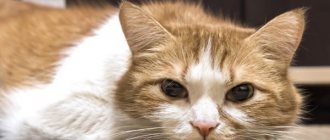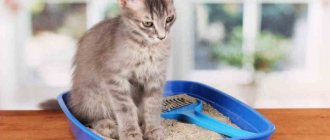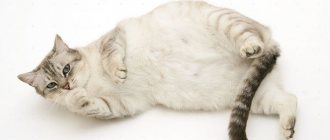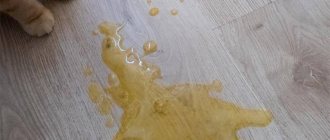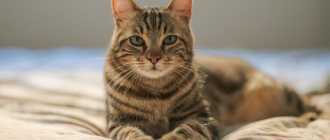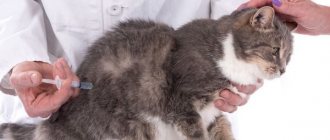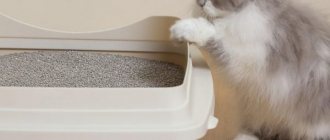When a cat vomits yellow liquid, this means two options: vomiting bile or eating a certain type of food. If a cat eats a specific food, it may vomit yellow color.
It is quite easy to distinguish it from bile: vomit has a gray tint.
In this case, there is no reason to worry; you simply need to exclude this type of food, since the cat’s body does not accept it.
The situation is different with rich yellow vomit - this means that bile has entered the cat’s stomach, which should not be in the cat’s stomach if the body is healthy.
The cat has yellow vomit: reasons
A yellow color indicates that the vomit came from the intestines and contains bile. There are physiological and pathological causes of vomiting.
Physiological causes of vomiting in cats
If attacks of vomiting occur periodically with a frequency of no more than three times a day, and the pet’s condition is satisfactory, we are most likely talking about a physiological reaction.
The following reasons are distinguished:
- Hungry vomiting: occurs in the morning, before meals. The cat gets rid of excess food consumed the day before.
- Toxicosis of pregnancy - observed 2-4 weeks after mating.
- Preventive cleansing of the gastrointestinal tract from hairballs. Sufferers are mainly long-haired pets that have a thick undercoat and swallow hairs when licking. The cat deliberately induces vomiting so that trichobezoars do not form from a mixture of hairs and intestinal contents. Otherwise, blockage of the digestive canal will occur. If the pet has access to the street, it eats grass, which provokes vomiting. Responsible owners of cats living in an apartment sow plants so that the pet can graze periodically.
Possible pathologies
Antiperistaltic contractions of the intestines throw bile into the stomach, from there into the esophagus and into the mouth.
Be sure to read:
Diarrhea in a kitten: what to do, first aid, causes, treatment, medications and folk remedies
The following causes of pathological vomiting are distinguished:
- Ingestion of an inedible object: curious pets can swallow small toys lying on the floor. It's worse if they have access to a trash can and container. Cats happily eat sausage casings. The polymer film partially or completely blocks the intestinal lumen. The gag reflex develops.
- Eating human food. If a cat is introduced to fatty foods gradually, there will be no negative reaction. The liver will adapt and begin to produce more bile. But when a large amount of tasty fatty food arrives suddenly, the body cannot cope and the brain gives the command to quickly get rid of the dangerous food.
- Inflammation of the gallbladder: formation of stones, damage by Giardia or trematodes.
- Complications when recovering from anesthesia after surgery.
- Poisoning from household chemicals or mice during deratization. Additional symptoms are diarrhea and a drop in temperature below normal.
- Helminthic infestation: parasites irritate the intestinal mucosa and release toxic metabolites.
- Disorders of urine excretion: intoxication and reflex vomiting develop.
- Viral infection: the most dangerous is panleukopenia, colloquially called feline distemper.
Causes of vomiting bile
If the owner is not very knowledgeable about such issues or has determined that the cat is vomiting bile, then it is necessary to immediately consult a veterinarian. The main reasons why a cat often vomits bile can be:
- stomach problems;
- liver disease;
- bowel or gallbladder disease.
All these problems can arise if your pet is not properly fed, for example, if he is fed too fatty food or even served treats from the dinner table.
A very significant number of owners sin by simply pouring food into the animal’s bowl that they did not finish themselves. Remember that for cats, sweet, salty, fatty and smoked foods equal death. Of course, your pet will not die immediately after being given a piece of smoked sausage, but over time, his body will gradually wear out due to such nutrition, and vomiting may also occur. It is preferable to feed the animal with food, but its size should not be too large, otherwise the food will simply stagnate in the pet’s stomach.
Yellow foam and vomiting - what does it mean?
Symptoms are characteristic of panleukopenia. Most often, unvaccinated kittens suffer. The infectious disease is highly lethal and requires seeking veterinary care.
Another reason is no less dangerous - poisoning with anticoagulants, which are used to poison rodents. The cat owner is unable to make an accurate diagnosis. Only a veterinarian in a clinic will conduct laboratory tests, ultrasound and other studies and prescribe treatment.
When should a cat be taken to the doctor for vomiting?
If your animal begins to vomit, and you cannot understand exactly how, it must be taken to a veterinary clinic as quickly as possible for a professional examination. It should be remembered that with any health problem, the most important thing is time - the less time passes from the moment symptoms are detected until hospitalization, the more likely it is that the animal will be able to fully recover.
Many owners, having read smart advice from the Internet, begin to guess on the tea leaves what happened to their cat and what further actions need to be taken. However, “armchair” experts do not know how the animal’s body works, what processes may occur in it, which is why they cannot know how to correctly diagnose and treat the animal.
If you are the owner of a cat, remember that the sooner you contact a veterinary clinic if your cat starts vomiting, the faster it will return to normal and there will be no complications. The life and health of pets is in the hands of the owner, and the more attentive he is, the longer the animal will live feeling good.
Treating vomiting in cats at home
If the cat vomits, but no other pathological symptoms are detected, then starvation treatment is carried out.
Healthy cats can go without food for 5 days, elderly and weakened individuals - 3 days. A fasting diet lasting more than 24 hours is contraindicated for kittens. During the time that the cat spends without food, pathological signals from the intestines to the brain are interrupted and the urge to vomit stops.
Be sure to read:
Reasons why a cat often goes to the toilet, pees a little, what to do
If the cat does not drink, you can inject a small amount of water with a syringe without a needle. When such actions lead to regurgitation, forced watering is stopped. If you do not have the skills to place a dropper, Ringer-Locke solution or saline is injected subcutaneously as much as possible. The resulting bumps quickly dissolve. Such manipulations will help hold out until the veterinarian arrives. You cannot use medical antiemetic drugs on your own so as not to harm your pet.
First aid and medications for vomiting in cats
First aid consists of fasting for at least 24 hours. Antiemetic drugs are prescribed by a veterinarian. If the cat is not drinking and there is a risk of dehydration, rehydration mixtures of electrolytes are administered subcutaneously.
Diet for vomiting
After a daily starvation diet, the cat is offered veterinary food in the form of canned food or pouches in soft packaging.
On the second day, feed no more than 1/3 of the daily requirement. If the pet eats and the vomiting has stopped, consumption is gradually brought back to normal. The contents of the spider must be fed within 24 hours, and canned food must be fed within 36 hours when stored in the refrigerator. Adherents of natural food should consult a veterinarian about dietary requirements.
Why does my cat feel sick and vomit?
Your veterinarian will ask many questions to determine why your cat is vomiting.
This includes:
- Have you recently changed your cat's diet?
- Have you started taking any prescription or over-the-counter medications?
- What diet, including all treats, is your cat on?
- Do you have other cats in the house, and if so, do they vomit too?
- Is your cat indoors and/or outdoors?
- How often does your cat vomit and what does it look like?
- Does your cat keep eating?
- Does your cat have other symptoms, such as diarrhea and/or weight loss?
- How long has your cat been vomiting?
There are several possible causes of vomiting in cats, and these questions will help point your veterinarian in the right direction. Possible causes of vomiting in cats can be divided into two categories: gastrointestinal causes and non-gastrointestinal causes.
Gastrointestinal causes of vomiting in cats
- Indiscretion in nutrition
- Foreign bodies
- Parasites
- Diet hypersensitivity
- Inflammatory bowel disease
- Constipation
- Cancer
- Ulceration
- Ingestion of toxins (ethylene glycol, chocolate, pesticides, etc.)
Causes of vomiting in cats not related to the gastrointestinal tract
- Pancreatitis
- Kidney disease
- Liver disease
- Diabetes
- Feline infectious peritonitis
- Cancer
- Neurological diseases
What to do for prevention?
If a cat vomits bile periodically, specialists at the Belyi Klyk veterinary clinic recommend monitoring the animal, normalizing its diet, and providing access to fresh drinking water. To prevent the cat from vomiting after castration, it is recommended to limit food a day before the operation and offer light food the day before. An antiemetic will also help in this case, if the doctor allows it to be used.
To prevent the development of dangerous diseases that negatively affect digestion and cause yellow vomiting, it is important not to skip routine vaccinations and deworming, and to take your pet for a preventive examination on time. In addition, it is useful to monitor the cat’s hygiene, comb it out of excess fur, give it vitamins and mineral complexes, avoid contact with street animals, regularly clean the litter box and wash the bowl with disinfectants, and use high-quality cat toys. If, in addition to yellow vomiting, other pathological symptoms are bothering you, and the owner notices that the cat is getting worse, you should not self-medicate or wait for the condition to normalize on its own. Only timely diagnosis and therapy will help avoid dangerous complications and improve the prognosis for recovery.
The mechanism of the gag reflex
Usually, owners believe that the cat vomited due to coughing. In fact, it is a symptom of vomiting, not a cause. The attack usually proceeds as follows:
- The cat appears to have increased salivation. She worries, constantly licks herself and swallows the saliva that forms.
- Then a cough begins, the animal breathes frequently and deeply, and stretches its head forward.
- The area of the pharynx and abdomen contracts, first fruitless vomiting appears, and then with the contents.
Important! For cats, vomiting every 3-4 days is normal.
Most often, cats vomit when they eat too quickly or eat too much. This often happens when feeding with low-quality industrial feed or with a mixed diet. Vomiting may also appear in the morning if the cat fell asleep hungry the day before.
If vomiting occurs from overeating, you just need to not let your pet eat or drink for 8 hours, and instead of water, offer to lick an ice cube. If a cat systematically vomits due to an incorrectly formulated diet, it needs to be reconsidered.
All long-haired cats also suffer from nausea and vomiting. When licked, the fur enters the stomach, where it gradually rolls into lumps, which cause irritation of the gastrointestinal tract. This is why burping fur should not be a concern. If there is blood, foam or mucus in the vomit, you should immediately contact the clinic.
Pregnant cat: what to look for?
If a pregnant cat burps, then in principle there is nothing to worry about. This condition is explained by excessive intoxication of the animal’s body. Of course, only if such symptoms occur in the morning.
It is necessary to take into account the composition of the masses. If there are no impurities there, then there is nothing to worry about.
And when spasms are repeated several times, and the discharge itself has various impurities, then you urgently need to show the animal to a doctor.
Of course, in any case, you need to understand that with such symptoms the body loses a lot of fluid. And even if this vomiting has no special reason, you should still take care of your pet’s health. Let's say that on such days you should change your diet, the food should be more dietary, and you need to add more moisture. But it should be given at certain intervals, so as not to further irritate the already inflamed stomach.
If a pregnant cat vomits yellow liquid, it is very dangerous.
If vomiting continues throughout the day, and sometimes for several days, then the animal should limit its food intake. Water should be given in small portions. And call a doctor immediately. It is especially dangerous when diarrhea begins along with it. In this case, the body loses 2 times more moisture.
Advice! Instead of plain water, you can make a herd of chamomile or flax; it has a calming effect on the stomach.
If a pregnant cat vomits yellow liquid, then this is very dangerous. In this case, you should not waste a minute and immediately seek help from a professional.
Associated symptoms
Yellow vomiting in a cat may be accompanied by additional symptoms depending on the cause that led to its appearance:
- the presence of hairballs, food particles, foam in the vomit;
- refusal to eat;
- deterioration in wool quality;
- constipation.
If you are repeatedly vomiting yellow liquid, you should give your cat something to drink as often as possible. If he does not drink on his own, it is recommended to pour liquid into his mouth every half hour to prevent dehydration. There is no need to feed the cat during this period.
Important! It is strictly forbidden to give your cat antiemetic drugs without a doctor's prescription.
If your pet's condition does not improve within a day, you should take him to the veterinarian.
